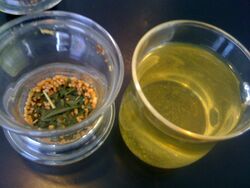
- Scientific name: camellia sinensis
- Japanese: お茶 (ocha)
Tea, in a variety of forms, is a central element of Japanese culture, and is commonly drunk in a variety of contexts, from the everyday, at home, in restaurants and teashops/cafés, to the more formal context of the tea ceremony. Throughout history, it was a major commercial and tribute good, grown both in China and Japan, and circulated domestically and overseas.
Cultivation & Production
With the exception of herbal teas, which include infusions of a wide variety of plant products from ginger to chrysanthemum or buckwheat, all "true" tea, including green tea, black tea, and white tea, is made from the leaves of the camellia sinensis plant.[1]
Tea in China was traditionally most heavily grown in Fujian and Guangdong provinces. Harvested tea leaves were first rolled in bamboo containers to draw out their oils, and were then place in iron woks over flames, in order to stop them from oxidizing further. The leaves were then dried, and ready to be packaged up for shipment or sale.[1]
History
Tea might have been first introduced to Japan in 805, when Saichô brought camellia sinensis seeds back from China. It first grew to significant popularity in China only about a hundred years earlier.[2]
Powdered tea is believed to have been introduced to Japan by Eisai in 1191, along with Rinzai Zen.[3]
The first sample batches of tea reached England around 1664. By the 1830s, more than 30 million pounds of tea were shipped from China to Britain every year.[1] China was, for a time, the world's only exporter of tea, and the volume of trade in the good was such that, at its height, tariffs on the importation of tea represented as much as 10% of total British government revenues.[4] Tea + silk constituted at least 50% of Chinese exports throughout the 19th century, peaking as high as 92% in 1842 and 93.5% in 1868, though this figure fell to 64.5% in 1890, just before the turn of the century. At least 40% of tea production in China was for export, and 50-70% of silk production, all the way to the 1920s.[5]
References
- ↑ 1.0 1.1 1.2 Matt Matsuda, Pacific Worlds, Cambridge University Press (2012), 192.
- ↑ Gallery labels, Asian Art Museum, San Francisco.
- ↑ Conrad Schirokauer, David Lurie, and Suzanne Gay, A Brief History of Japanese Civilization, Wadsworth Cengage (2013), 81.
- ↑ Lloyd Eastman, Family, Fields, and Ancestors: Constancy and Change in China's Social and Economic History, 1550-1949, Oxford University Press (1988), 128.
- ↑ Joseph Esherick, "Harvard on China: The Apologetics of Imperialism." Bulletin of Concerned Asian Scholars 4:4 (1972), 10.